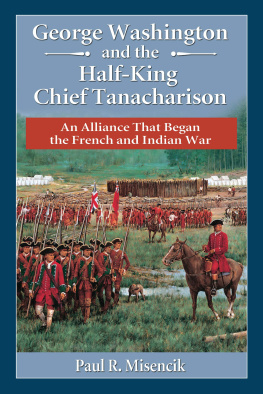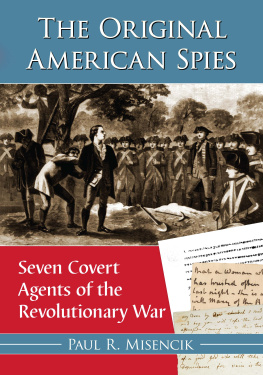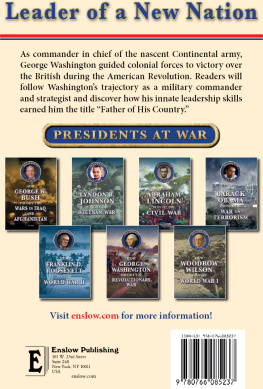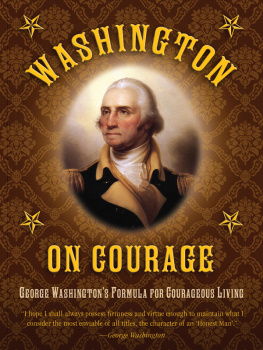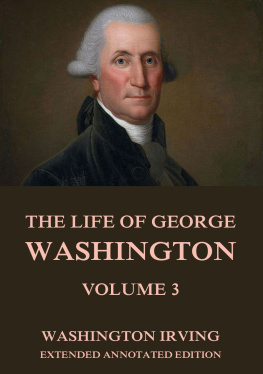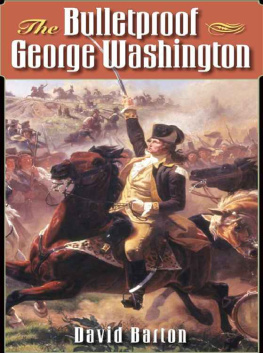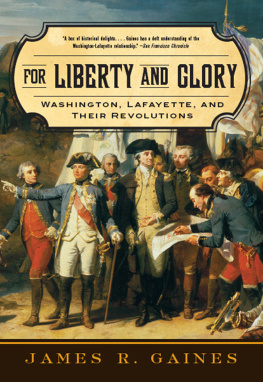
George Washington and the Half-King Chief Tanacharison
An Alliance That Began the French and Indian War
Paul R. Misencik

McFarland & Company, Inc., Publishers
Jefferson, North Carolina
LIBRARY OF CONGRESS CATALOGUING DATA ARE AVAILABLE
BRITISH LIBRARY CATALOGUING DATA ARE AVAILABLE
e-ISBN: 978-1-4766-1540-0
2014 Paul R. Misencik. All rights reserved
No part of this book may be reproduced or transmitted in any form or by any means, electronic or mechanical, including photocopying or recording, or by any information storage and retrieval system, without permission in writing from the publisher.
On the cover: A Charming Field for an Encounter by Robert Griffing (Paramount Press, Inc.)
McFarland & Company, Inc., Publishers
Box 611, Jefferson, North Carolina 28640
www.mcfarlandpub.com
This book is dedicated to my family:
my wife, Sally, my daughter, Karen, and my son, Paul Jr.
Without their love, encouragement and
assistance this book would never have been written.
Preface
The French and Indian War has captivated those with an interest in American history almost from the time it was fought. It contained all of the elements that typified the clichd American romantic ideal: remote wilderness forts, resourceful frontiersmen, wild Indian tribes, and savage battles fought in the rugged mountains and primitive forests of a largely uninhabited continent.
Most students of history are aware of the significant facts and events of the French and Indian War in that it was primarily a wilderness war between England and France, and that it began with an early morning exchange of musketry in a very remote forest glen between troops under young George Washington and the French officer Ensign Jumonville, who was killed in that skirmish. Students of history also realize that the forests, which became battlefields in that war, were the homelands of American Indians who had lived there for centuries, and who found themselves caught up in the Anglo-French struggle for the continent. The war itself has been the subject of many scholarly works, which detail the basis of French and English claims to the territory, the campaigns, battles, and the major European and colonial personalities who took part in the war. However, little emphasis has been placed on the specific chain of events that led to the fatal confrontation at Jumonville Glen, or for that matter, the Indians motivations and involvement in the cumulative occurrences that precipitated the French and Indian War. Along with the Indians relationships and interactions with both European powers, this book explores some of the more significant reasons for their participation in those events.
There are a myriad of works on the life of George Washington, and while most detail his missions and accomplishments, few delve into the personality of young Washington during his first experiences as a military leader. This work examines Washington who, barely into his twenties, accepted incredibly daunting missions into the wilderness on behalf of the lieutenant governor of Virginia, and how Washington faced the numerous challenges he was forced to address on his own. Among those challenges was the necessity of winning the friendship and support of the Ohio Indians, who were caught in the middle of the Anglo-French controversy. Washingtons other more pressing challenge was to take command of a disparate force of colonial troops and somehow on his own, evict a larger, more powerful and veteran French army from the disputed area of the upper Ohio and Allegheny Rivers. With no one else to provide him with support and advice, Washington turned to the sage and wily Seneca half-king Tanacharison for assistance. However, Washington was not yet aware that Tanacharison had a mission of his own that required Washingtons involvement in precipitating a war with France. This book studies the relationship between young Washington and Tanacharison and how each sought to influence the other to further their respective agendas.
It is well documented that the Indians were recruited by both sides prior to and during the conflict, but there are few studies that shed light on why the Indians were willing to join in a war between two European powers, or why they chose to ally themselves with one side over the other. Certainly there were ancient enmities between Indian nations, like the bitter hostility between the Huron and Iroquois confederacies, which some historians allude to as the definitive reason for those particular nations aligning themselves on opposite sides in the war. Those thoughts may be overly simplistic, but they have been reinforced for generations in all genres that pertained to the war. Even romanticized novels like James Fenimore Coopers The Last of the Mohicans helped promulgate the notion that hereditary animosities were the overriding reasons for an Indian nations particular allegiance. They convey the idea that, quite simply, the Indians chose a side because their ancient tribal enemies were associated with the other.
While the blood feud mentality that existed among some Indian societies may have had a significant impact on determining their alliances, those decisions were often arrived at because of more current situations that generally affected their economy or their way of life. The respective Indian nations and indeed the individual tribes who found themselves caught up in the prelude to the war between France and England were far more sophisticated and pragmatic regarding frontier diplomacy and how various alliances would affect them than most white people realized. White leaders on both sides considered the Indians as simple savages or, at best, as nave children. They constantly used patronizing terms in communications with the Indians, referring to the Indians as my children and to themselves as your father. For the most part, they believed that it was their trade goods, technological superiority, military power, and eloquence that brought the Indians over to their side. In reality, the reasons that the Indians allied themselves with either the French or the English were far more subtle and complex. These are the facets this work explores: primarily the relationships between the Indians and the French and the English, and indeed between the various Indian societies themselves. Not surprisingly, it provides another perspective in examining reasons for the Indians direct and overt participation in events that led to a war that they knew would certainly encompass them and their families.
My interest in Native American history came naturally to me as a young person growing up in rural Ohio. The melodic Indian place names, beautiful petroglyphs, and the flint arrowheads that I found in the newly plowed fields behind our home were reminders of the Indians who once lived there. Those tantalizing mementos captured my interest to the point where I wanted to learn all I could about these vanished people and their way of life. As a student prior to and during high school, I was fortunate to have met several old-timers who were veterans of the Indian wars in the west, and the tales of their encounters with the western Indians were enthralling. However, the wild Indians of Ohio and the northeastern woodlands had vanished long before. There were no longer any living souls who could talk about encountering them in their natural state. The Ohio Indians left only their bones, their arrowheads, and their magnificent place names as reminders that they were once the masters there. The best I could do at the time was to visit the places where they once lived, hunted, traveled, or traded before they moved on or died. Among my most prized processions at the time was a signed edition of
Next page
